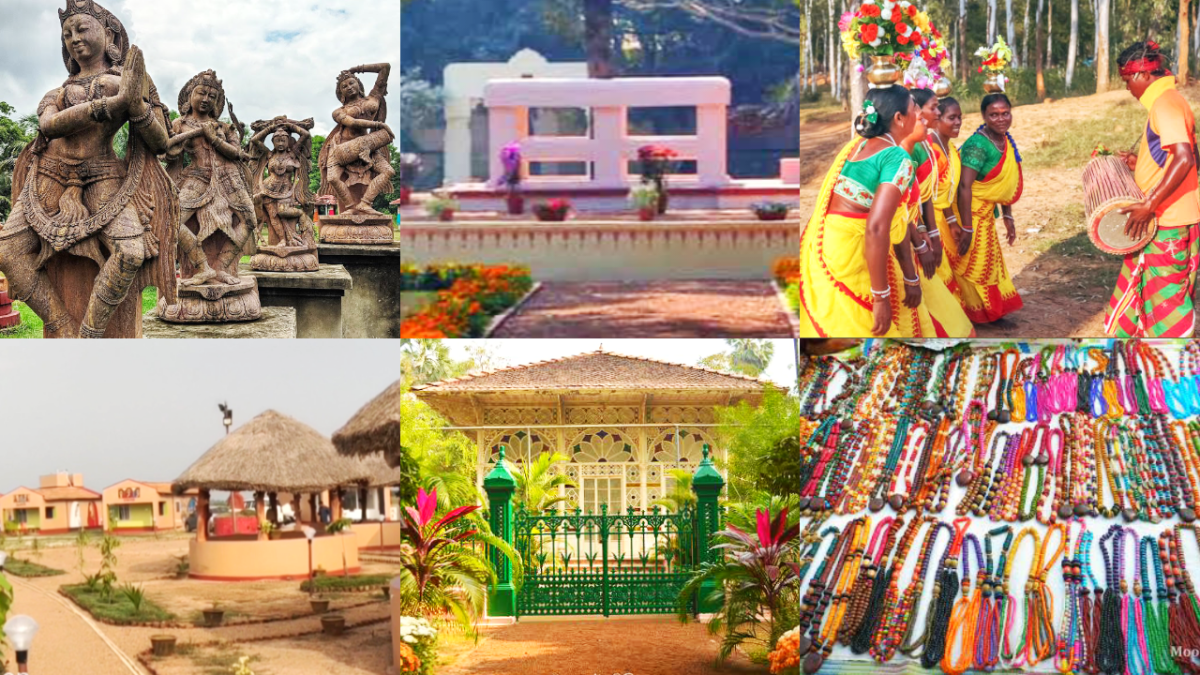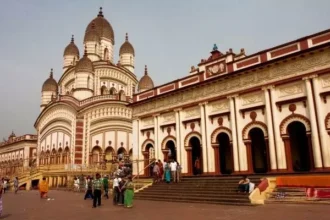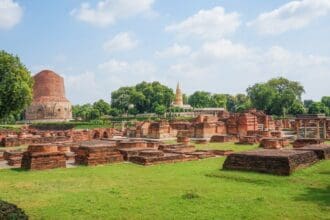Nestled in the heart of West Bengal, Shantiniketan is a serene town that embodies the essence of art, culture, and nature. Founded by Nobel laureate Rabindranath Tagore, this idyllic destination serves as a hub for creativity, learning, and spiritual enlightenment. Known for its lush greenery, vibrant festivals, and rich heritage, Shantiniketan offers a unique blend of tradition and modernity. Whether you’re an art enthusiast, history buff, or nature lover, Shantiniketan has something for everyone. In this comprehensive guide, we will take you through the top 5 places to visit in Shantiniketan , ensuring your journey is as enriching as it is memorable.
1. Visva-Bharati University: The Epicenter of Learning and Creativity
A Legacy of Education
The Visva-Bharati University , founded by Rabindranath Tagore in 1921, is the heart and soul of Shantiniketan. This prestigious institution was envisioned as a place where education transcends traditional boundaries, fostering creativity, cultural exchange, and holistic development. It became a central university in 1951 and continues to uphold Tagore’s vision of blending Indian traditions with global perspectives.
Exploring the Campus
The sprawling campus of Visva-Bharati is dotted with open-air classrooms, art studios, libraries, and museums. Students and faculty often engage in discussions under the shade of ancient trees, reflecting the university’s philosophy of learning in harmony with nature. Visitors can explore iconic landmarks like Cheena Bhavana (the Chinese studies department), Kala Bhavana (the fine arts department), and Sangeet Bhavana (the music and performing arts department).
Why It’s a Must-Visit
For those who appreciate education as a transformative experience, the Visva-Bharati University is a living testament to Tagore’s ideals. Its serene ambiance and artistic vibrancy make it a must-visit destination in Shantiniketan.
“At Visva-Bharati, knowledge flows as freely as the breeze, nurturing minds and souls alike.”
Detailed Insights into Visva-Bharati University
To fully understand the significance of Visva-Bharati University, let us delve deeper into its historical context, academic contributions, and visitor experience.
Historical Context
Tagore established Visva-Bharati as a response to the rigid and colonial education system prevalent during British rule. He envisioned it as a space where students could learn without constraints, embracing both Indian traditions and global cultures. Over the decades, the university has produced renowned artists, writers, and thinkers who have contributed significantly to India’s cultural landscape.
Artistic Contributions
The university is home to some of India’s finest art and music programs. Kala Bhavana, in particular, has nurtured legendary artists like Nandalal Bose and Ramkinkar Baij. Sangeet Bhavana has played a pivotal role in preserving and promoting classical Indian music and dance forms.
Visitor Experience
While the university primarily functions as an educational institution, guided tours are available for visitors. These tours provide insights into the university’s history, architecture, and ongoing projects. Special events, such as art exhibitions and musical performances, are often open to the public.
Photography Opportunities
The campus offers endless opportunities for photography enthusiasts. From panoramic shots of open-air classrooms to close-ups of intricate murals and sculptures, the possibilities are limitless. Early morning visits are particularly recommended, as the soft light enhances the colors of the surroundings.
2. Upasana Griha: A Spiritual Retreat
A Place of Worship and Reflection
The Upasana Griha , located within the Visva-Bharati campus, is a sacred space designed for meditation and spiritual gatherings. Built in the shape of a lotus, this prayer hall reflects Tagore’s vision of universal spirituality, transcending religious boundaries.
What to Expect
Visitors can attend daily prayers and hymns sung by students and faculty members. The tranquil atmosphere and minimalist design create a meditative ambiance, perfect for introspection. The walls are adorned with verses from Tagore’s poems, emphasizing themes of unity, peace, and harmony.
Why It Stands Out
For spiritual seekers and culture enthusiasts, the Upasana Griha offers a unique blend of devotion and tranquility. Its architectural simplicity and philosophical depth make it a standout attraction in Shantiniketan.
“At Upasana Griha, silence speaks louder than words, inviting you to connect with your inner self.”
Detailed Insights into Upasana Griha
Upasana Griha is more than just a prayer hall; it is a sanctuary for those seeking solace and spiritual enlightenment. Let’s explore what makes this destination so captivating.
Architectural Features
The building’s lotus-inspired design symbolizes purity and spiritual growth. Its open structure allows natural light to filter in, creating a serene and uplifting environment. The absence of religious symbols ensures inclusivity, welcoming people of all faiths.
Spiritual Practices
Daily prayers at Upasana Griha include recitations of Tagore’s devotional songs (Brahma Sangeet) and readings from various scriptures. These rituals emphasize the universality of spiritual practices, encouraging participants to reflect on shared human values.
Visitor Guidelines
Visitors are advised to maintain silence and respect the sanctity of the space. Shoes must be removed before entering the hall, and photography is restricted during prayer sessions.
Cultural Significance
Upasana Griha plays a crucial role in fostering a sense of community among students and faculty. It serves as a reminder of Tagore’s belief in the interconnectedness of humanity and nature.
3. Kankalitala Temple: A Sacred Pilgrimage Site
A Revered Shrine
The Kankalitala Temple , located near Shantiniketan, is a revered Hindu shrine dedicated to Goddess Kankali. According to local legends, the temple dates back over 800 years and is believed to possess miraculous powers. Pilgrims from across India flock here to seek blessings and fulfill their vows.
Exploring the Temple
The temple complex features intricate carvings and sculptures depicting scenes from Hindu mythology. A small pond near the temple adds to its serene ambiance, making it an ideal spot for reflection and meditation. During festivals like Navratri and Durga Puja, the temple comes alive with rituals, music, and festivities.
Why It’s Worth Visiting
For spiritual seekers and culture enthusiasts, the Kankalitala Temple offers a unique blend of devotion and tranquility. Its historical significance and scenic location make it a must-visit destination.
“At Kankalitala Temple, faith meets beauty, creating an aura of divine serenity.”
Detailed Insights into Kankalitala Temple
Kankalitala Temple is not just a religious site; it is a testament to the region’s rich cultural heritage. Let’s uncover some of the elements that make this temple so special.
Mythological Context
According to legend, the temple was built by a local king after he received a vision of Goddess Kankali. She instructed him to construct the shrine to protect the region from evil forces. Over the centuries, the temple has become a symbol of hope and resilience for devotees.
Festivals and Celebrations
The temple hosts grand celebrations during Navratri, attracting thousands of pilgrims. Rituals such as aarti (prayer with lamps) and havan (fire ceremony) are performed regularly, creating an aura of devotion. Many tie sacred threads on trees as a symbol of their vows and prayers.
Photography Opportunities
The temple provides endless opportunities for photography enthusiasts. From close-ups of intricate carvings to wide-angle shots of the surrounding landscape, the possibilities are limitless. Sunset visits are particularly recommended, as the golden hues cast a magical glow over the temple.
4. Deer Park (Mrinmoyee): A Wildlife Oasis
A Sanctuary for Spotted Deer
The Deer Park , also known as Mrinmoyee, is a haven for wildlife enthusiasts. Located within the Visva-Bharati campus, this park is home to a thriving population of spotted deer (chital). The lush greenery and tranquil environment make it a perfect spot for nature walks and picnics.
Exploring the Park
Visitors can observe the deer grazing peacefully in their natural habitat. The park also features walking trails, benches, and shaded areas, providing ample opportunities for relaxation. Birdwatchers may spot species like peacocks, parakeets, and bulbuls flitting among the trees.
Why It’s Unique
The Deer Park stands out for its commitment to conservation and education. It serves as a living classroom, teaching visitors about the importance of protecting wildlife and preserving natural habitats.
“At Deer Park, nature’s grace is on full display, leaving visitors awestruck.”
Detailed Insights into Deer Park
Deer Park is more than just a recreational space; it is a microcosm of Shantiniketan’s efforts to balance development with environmental preservation. Let’s examine what makes this destination so captivating.
Conservation Efforts
The park plays a vital role in conserving the spotted deer population, which faces threats from habitat loss and poaching. Rangers and volunteers monitor the animals closely, ensuring their safety and well-being. Educational programs aim to raise awareness about the importance of wildlife conservation.
Nature Trails
Well-marked trails wind through the park, catering to hikers of all skill levels. Information boards provide insights into the local flora and fauna, enhancing the overall experience. Guided tours are available, offering deeper insights into the park’s ecosystem.
Photography Tips
To capture the perfect shot, bring a telephoto lens to zoom in on distant deer and birds. Early morning visits are recommended, as the animals are most active during these hours. Soft lighting enhances the colors of the surroundings, creating stunning visuals.
5. Ballavpur Wildlife Sanctuary: A Biodiversity Hotspot
A Natural Paradise
The Ballavpur Wildlife Sanctuary , located approximately 12 kilometers from Shantiniketan, is a protected area teeming with biodiversity. Spread across 18 square kilometers, this sanctuary is home to a variety of wildlife, including deer, jackals, foxes, and numerous bird species.
What to Do
Visitors can embark on guided treks through the sanctuary, where they may encounter exotic flora and fauna. Birdwatchers will be delighted by the sight of rare species like the Indian roller, paradise flycatcher, and crested serpent eagle. The sanctuary also features picnic spots and watchtowers, offering panoramic views of the surrounding landscape.
Why It’s Special
For nature lovers and adventure seekers, the Ballavpur Wildlife Sanctuary offers a unique opportunity to connect with the wild. Its untouched beauty and diverse ecosystems make it a standout attraction in Shantiniketan.
“At Ballavpur Wildlife Sanctuary, every step feels like a journey into the heart of nature.”
Detailed Insights into Ballavpur Wildlife Sanctuary
Ballavpur Wildlife Sanctuary is more than just a protected area; it is a testament to the region’s commitment to preserving its natural heritage. Let’s explore what makes this destination so captivating.
Ecological Importance
The sanctuary plays a crucial role in maintaining the ecological balance of the region. Its dense forests act as a carbon sink, while its water sources feed nearby rivers and streams. The sanctuary also serves as a critical habitat for endangered species, contributing to global conservation efforts.
Adventure Activities
For thrill-seekers, Ballavpur Wildlife Sanctuary offers opportunities for trekking, birdwatching, and camping. Adventure camps organized by local operators provide equipment and guidance, ensuring a safe and enjoyable experience.
Photography Opportunities
The sanctuary provides endless opportunities for photography enthusiasts. From close-up shots of exotic birds to wide-angle landscapes capturing the majestic forests, the possibilities are limitless. Early morning visits are particularly recommended, as the soft light enhances the colors of the surroundings.
Other Notable Attractions Near Shantiniketan
While the above five destinations are the highlights of Shantiniketan, there are several other attractions worth exploring:
Rabindra Bhavan Museum
This museum houses a vast collection of Tagore’s personal belongings, manuscripts, paintings, and photographs, offering a glimpse into his life and legacy.
Chhatimtala
A sacred grove within the Visva-Bharati campus, Chhatimtala is the final resting place of Rabindranath Tagore and his family members. It exudes a serene and spiritual ambiance.
Tips for Travelers Visiting Shantiniketan
To ensure a smooth and enjoyable trip, keep the following tips in mind:
- Best Time to Visit : October to March is ideal due to pleasant weather.
- Permits : No special permits are required for visiting Shantiniketan.
- Local Cuisine : Try regional delicacies like luchi-alur dom, mishti doi, and sandesh.
- Respect Local Customs : Dress modestly and seek permission before photographing religious sites.
Conclusion
Shantiniketan is more than just a town; it’s a celebration of art, culture, and nature. From the intellectual vibrancy of Visva-Bharati University to the tranquil beauty of Ballavpur Wildlife Sanctuary , each location offers a unique perspective on what makes this region so special. By embracing sustainable tourism and respecting local traditions, we can ensure that future generations continue to cherish these treasures.
“In Shantiniketan, every path leads to inspiration, and every moment becomes a cherished memory.”
Frequently Asked Questions (FAQs)
- What is the best time to visit Shantiniketan?
- The best time to visit is between October and March when the weather is mild and pleasant.
- Do I need permits to enter Shantiniketan?
- No, no special permits are required for visiting Shantiniketan.
- How do I reach Shantiniketan?
- Shantiniketan is accessible via road from Kolkata (approximately 160 kilometers). The nearest railway station is Bolpur.
- Are there accommodation options available?
- Yes, there are hotels, guesthouses, and homestays catering to different budgets.
- What activities can I enjoy in Shantiniketan?
- Popular activities include visiting museums, attending cultural events, exploring temples, and enjoying nature walks.
- Is Shantiniketan safe for solo travelers?
- Yes, Shantiniketan is generally safe, but it’s advisable to stay informed about local guidelines.
- Can I visit Kankalitala Temple from Shantiniketan?
- Yes, it is easily accessible by road.
- What should I pack for my trip?
- Pack comfortable clothing, sturdy shoes, sunscreen, insect repellent, and a camera.
- Are there medical facilities available?
- Basic healthcare services are available, but it’s recommended to carry a first aid kit.
- What makes Shantiniketan unique compared to other destinations?
- Its combination of artistic vibrancy, spiritual significance, and natural beauty sets it apart.














